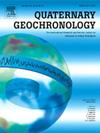Reconstructing the Holocene volcanic past of El Hierro, Canary Islands
IF 2.5
2区 地球科学
Q3 GEOGRAPHY, PHYSICAL
引用次数: 0
Abstract
We present a geochronologic study with unprecedented detail from 42 Holocene subaerial volcanic edifices of El Hierro Island, Canary Islands. The study of new and published K-Ar, 40Ar/39Ar, 14C, and paleomagnetic ages, constrained by stratigraphic, geomorphic, and anthracological criteria, significantly improves the geochronologic framework of the Holocene volcanism at El Hierro. Our combined experiments show that radiocarbon and paleomagnetic dating were the best methods to determine this young volcanism's age. Indeed, small amounts of 40Ar∗ detected in most dated samples do not allow for calculating geologically significant ages. The preliminary anthracological study of charcoals is recommended before 14C dating. Thirty-six eruptive events (86 % of the total) were retained for the geochronological model developed with ChronoModel combining radiocarbon and paleomagnetic and using the Bayesian inference. Seventeen eruptions were dated for the first time. The Holocene eruptive activity at El Hierro exhibits significant variability over time, with recurrence intervals ranging from 34 to 1078 years. The most recent subaerial eruptions were Lomo Negro, 1412 [1560, 1242] cal BP (MAP, mode of the posterior distribution, and 95 % highest posterior density (HPD) interval) and Montaña del Tesoro, 1059 [1206, 967] cal BP. In addition, historical records suggest possible submarine eruptions in 1721, 1777, and 1793, as well as the more recent and well-documented Tagoro volcano submarine eruption (2011–2012 CE). This recent low recurrence subaerial volcanic activity is unusual for an oceanic volcanic island in the juvenile shield growth stage. The volcanic edifices resulted from hybrid Strombolian monogenetic eruptions with alternating or simultaneous emission of pyroclastic tephra and lava flows. The absence of lava flows in the eruptions of the highest part of the island's summit is worth noting. This volcanic activity focused on the three rifts that configure the tetrahedral shape of the island, although the NW rift concentrated 50 % of the eruptions. These results contextualize the volcanic hazard of El Hierro in the face of eventual future eruptions.

重建加那利群岛耶罗岛的全新世火山历史
我们对加那利群岛耶罗岛的42个全新世陆上火山大厦进行了地质年代学研究,其细节前所未有。根据地层、地貌和人类学标准,对El耶罗全新世火山活动的地质年代学框架进行了新的和已发表的K-Ar、40Ar/39Ar、14C和古地磁年龄的研究。我们的联合实验表明,放射性碳和古地磁测年法是确定这个年轻火山活动年龄的最佳方法。事实上,在大多数定年样品中检测到的少量40Ar *不能计算出具有地质意义的年龄。建议在14C定年之前对木炭进行初步的人类学研究。使用ChronoModel结合放射性碳和古地磁并使用贝叶斯推断建立的地质年代学模型保留了36次喷发事件(占总数的86%)。首次确定了17次喷发的日期。El耶罗全新世火山喷发活动呈现出明显的时间变异性,其复发间隔为34 ~ 1078年。最近的地面喷发是Lomo Negro, 1412 [1560, 1242] cal BP (MAP,后验分布模式,95%最高后验密度(HPD)间隔)和Montaña del Tesoro, 1059 [1206, 967] cal BP。此外,历史记录表明,1721年、1777年和1793年可能有海底喷发,以及更近的、有详细记录的塔哥罗火山海底喷发(公元2011-2012年)。这种低复发的陆基火山活动对于处于幼年盾构生长阶段的海洋火山岛来说是不寻常的。火山大厦是由混合的斯特龙堡单成因喷发形成的,火山碎屑熔岩和熔岩流交替或同时喷发。值得注意的是,在该岛最高峰的喷发中没有熔岩流。这次火山活动集中在形成岛屿四面体形状的三个裂谷上,尽管西北裂谷集中了50%的火山喷发。这些结果说明了耶罗岛在面对未来最终爆发时的火山危险。
本文章由计算机程序翻译,如有差异,请以英文原文为准。
求助全文
约1分钟内获得全文
求助全文
来源期刊

Quaternary Geochronology
地学-地球化学与地球物理
CiteScore
4.40
自引率
22.20%
发文量
130
审稿时长
20 weeks
期刊介绍:
Quaternary Geochronology is an international journal devoted to the publication of the highest-quality, peer-reviewed articles on all aspects of dating methods applicable to the Quaternary Period - the last 2.6 million years of Earth history. Reliable ages are fundamental to place changes in climates, landscapes, flora and fauna - including the evolution and ecological impact of humans - in their correct temporal sequence, and to understand the tempo and mode of geological and biological processes.
 求助内容:
求助内容: 应助结果提醒方式:
应助结果提醒方式:


